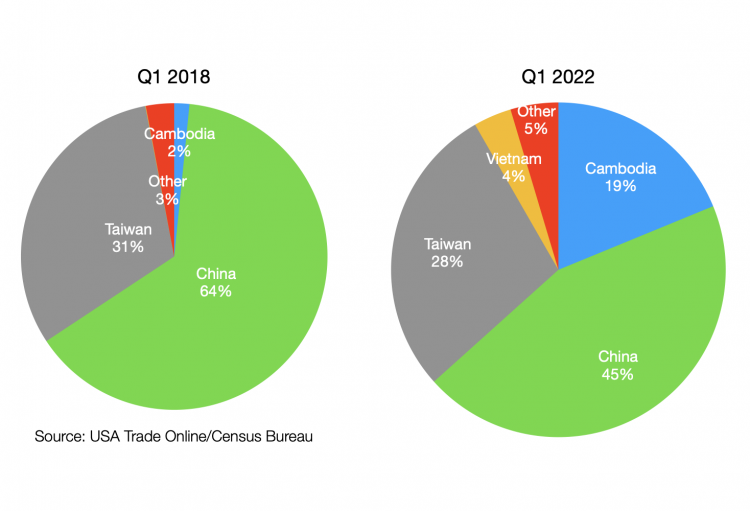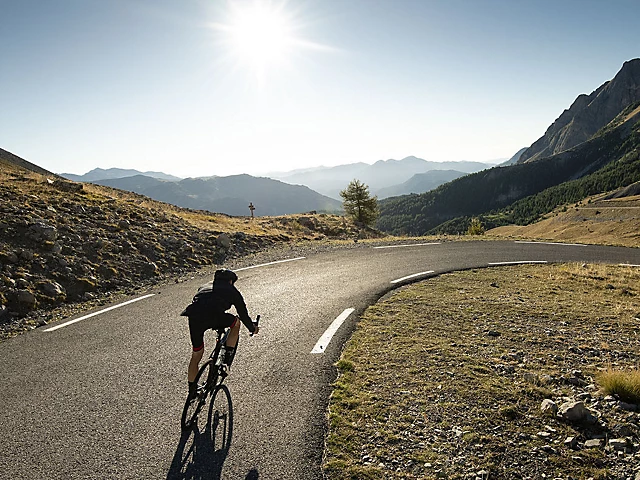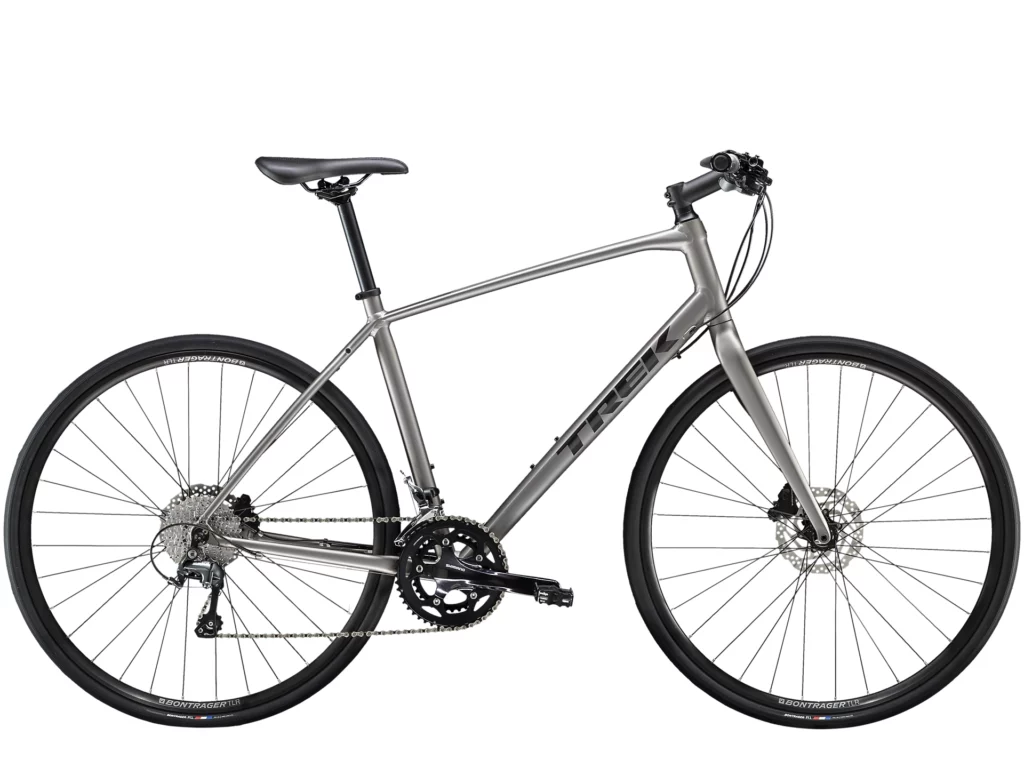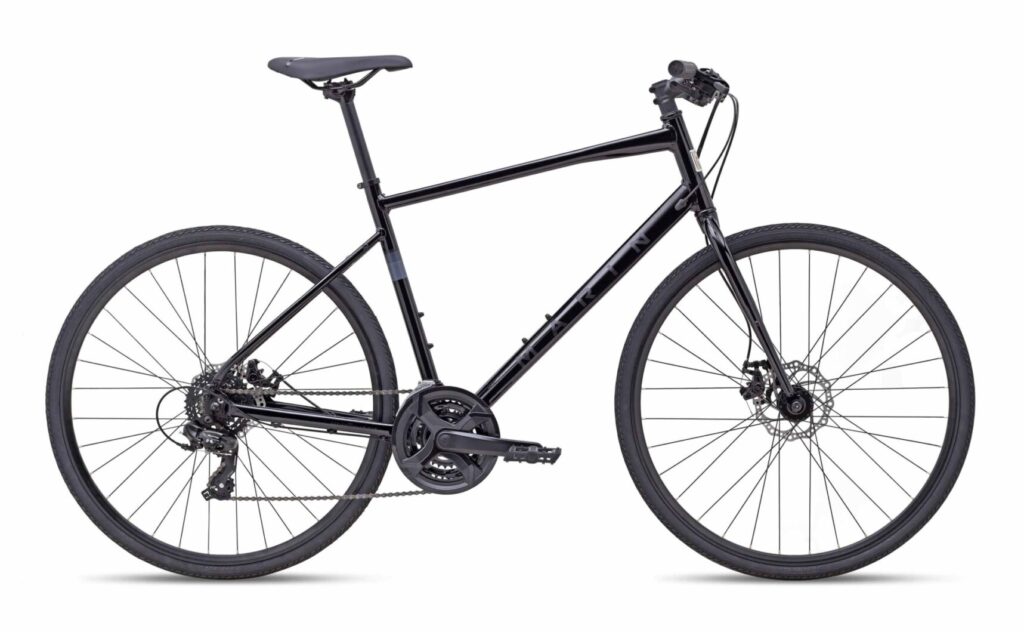This is a subject I’ve been looking forward to writing, as I’m in the market for a bike myself. Growing up I rode a road bike, and in my young adulthood I rode a mountain bike. I’ve decided for my next bike to get a hybrid, but if you’re in the market for a road or mountain bike, the advice here most likely applies to you too if you’re looking for the best brand to buy that has avoided China manufacturing.
What’s a Hybrid Bicycle?
Think of a hybrid bike as a cross between a road bike and a mountain bike.
Road bikes are lightweight and generally have really, really thin tires that allow you to go at exceedingly fast speeds on flat surfaces. They typically have curved handlebars that force you to bend your body down in a way that gives you even faster aerodynamics. They’re great bikes, except if you find yourself on a dirt path or a road that’s not perfectly paved.
Mountain bikes, on the other hand, have really, really thick tires. They have flat handlebars and allow you to rid on just about any surface imaginable–dirt roads, unpaved roads, mountain trails, and even gravel or cobblestone. They’re heavier, which means they’re easier to control.
Road bikes and mountain bikes couldn’t be more different than each other except in one area. The best ones are really, really expensive. Why? Because enthusiasts will pay gladly pay $5,000-$10,000 for a great road bike or mountain bike.

Hybrids bring together the best of both worlds, at least in the eyes of those of us who bike casually and just want a bike we can use for commuting or fitness. Generally speaking, they have tires that are thicker than road bikes and thinner than mountain bikes. Their weight will also be somewhere between road bikes and mountain bikes. They generally have flat handlebars.
One other nice thing about hybrid bikes is that because they’re made for casual riders, you can get the top of the line at a pretty affordable price. The overall market for bicycles is about evenly split between mountain bikes, road bikes, and hybrid bikes (which depending on where you shop are also being marketing as fitness bikes, urban bikes, commuter bikes).
A Giant Disappointment

When I started my shopping, there was only one manufacturer I had in mind: Giant Bicycles. Giant Manufacturing Co. Ltd was founded in Taiwan in 1972. They had a deal with Schwinn to manufacture their bikes as an OEM, so if you grew up riding a Schwinn bike in the 1970s or 1980s, there’s a good chance it was manufactured in Taiwan by Giant. At one point 75% of Giant’s sales were from Schwinn-branded bikes.
In 1987, Schwinn was one of the first American brands to sell out to China, switching from Giant to the “China Bicycle Company”. Sadly, millions of Americans just continued to blindly buy Schwinn because they knew the brand, a phenomenon that would continue across more and more brands that were once proud US brands but which became shadows of their former selves when their executives sold out to China.
It’s around this time that Giant started making their own branded bikes. I was in college during this time, and I became a Trek loyalist, until I started hearing rumors that Trek was outsourcing to China. I resolved that my next bike would be a Giant. There’s the sentimental value of knowing that they likely manufactured my beloved purple boy’s bike in the 1970s and my red 5-speed Schwinn in the 1980s, and there’s the value of supporting a Taiwan-based company.
Sadly, I reached out to Giant, and had the chat session that you see to the right. It would have been simple for “Alec” to get a quick $1000-2000 from me as a customer–just come out and be transparent with me.
The fact that Alec was contorting so hard to avoid giving me an answer spoke louder to me than anything else he could have said.
The Effect of the 2018 Tariffs
In 2019, following Trump’s tariffs on China, Giant spokeswoman Bonnie Tu famously declared that “The Era of Made in China is Over”. Upon re-reading her words, one line stuck out at me that I hadn’t noticed before. “Giant still has five Chinese plants and Tu confirmed that if the tariffs are lifted, they would move production back right away”.
In other words, when Tu made that declaration in 2019 it wasn’t a declaration of triumph, it was a declaration of defeat and anger at the US government for putting limits on China. It’s tragic how a Taiwanese company is so eager to enrich a government whose primary mission is to destroy Taiwan–heaven knows that Giant has a strong enough brand that it doesn’t need to rely on China. But sadly, Giant is just the latest of many Taiwanese firms to go all-in on China. It’s quite literally corporate suicide, but these corporate executives have zero long-term vision when they focus on their quarterly earnings.
Surely enough, in 2022, the US government excluded tariffs on some bicycles, eliciting celebration from companies like Huffy, Specialized, and bike retailers who care more about saving a few dollars on a bike than funding human rights abuses (or even lifting a finger to try to find alternate suppliers). And as I’m writing this the Biden Administration is mulling over lifting even more tariffs, despite the clear benefits they are having to moving manufacturing out of China.
On the flip side, as I contacted other brands, I was happy to hear of those who decided to make meaningful and (hopefully) long-standing changes to their supply chain after the 2018 tariffs, and NOT to “wait out the clock” as Giant apparently has done. A very helpful rep from Cannondale confirmed to me that all of its bikes are being made in Taiwan. Someone from Trek confirmed to me that in recent years (likely since 2018), Trek has been turning from China to Taiwan, Cambodia, and Vietnam. No tap-dancing like the Giant guy.
This chart that I saw on Bicycle Retailer tells the story of the 2018 tariffs. Taiwan’s share of manufacturing didn’t really grow, given that labor costs there are rising and they’re increasingly a place where only the highest end and highest margin parts are being made. But the tariffs did push a lot of the manufacturing that China had been hoarding for years to countries like Vietnam and Cambodia–something that should have happened years ago but which the CCP artificially kept from happening through government subsidies and looking the other way on labor and environmental practices that made it impossible for any other country to compete on price.

Let’s hope that President Biden keeps those tariffs in place, as it clearly has been resulting in positive diversification of the supply chain. Removing those tariffs would mean that all the progress of the last four years will be wiped away: manufacturers who dared moved their supply chains outside of China will get punished and China will be allowed to continue its monopolization of the supply chain by stealing intellectual property and continuing with government-sanctioned abuse of labor and environmental practices.
Bottom line, if you’re in the market for a bike, support a manufacturer who has made a deliberate attempt to move their supply chain out of China since 2018, not one who is spending their energy lobbying the government to allow them to continue to exploit cheap China labor.



1. Trek FX 3 Disc and FX Sport 4

I admit, I’m putting this option first for sentimental reasons. I had a bad accident on my Schwinn bike when I was in junior high school, and I never touched a bike again until after college, when I got a paycheck and could afford to buy a more expensive bike. My first bike was a beautiful light blue Trek 820. I loved that thing, until it got stolen. But I saved up money again and replaced it with a Trek 4300. That’s been a workhorse for 20 years now.
Trek has been making bikes since 1975. As with many great American brands it started out with a huge factory in Wisconsin, but quickly outgrew its US-based factory and had to establish new manufacturing facilities in the Netherlands, Germany, Taiwan, and yes, China.
Trek currently has about a 23% market share by sales, second only to Giant at 32%. At a certain point it looks like Trek was going all-in on China. Everywhere you turned, people were reporting not just low-end Trek bikes, but high end ones were coming out of China.
But the 2018 tariffs seemed to do a good job. I called Trek asked if the rep could look up a few models for me that I was interested in, specifically the FX 3 Disc and the FX Sport 4. He said the FX Sport 4 was definitely made in Cambodia, while his system listed the FX Disc 3 as being “dual source”. While that’s the extent of the information he was given, he went above and beyond the Giant guy by saying that from his observation, that probably meant Taiwan, Cambodia, or Vietnam. He told me that he didn’t see many if any bikes coming out of China in recent years, but that I should check with the bike store to be sure. I appreciated his transparency and candor.
The Trek FX 3 Disc has been named to many “best of” lists, including Cycling News. The Trek Sport 4 adds a carbon fiber frame. At $1000 and $1700 respectively they’re not the cheapest bikes out there, but they’re a great choice if you’re ready to graduate to the next level of biking (if you prefer a lower cost model, the FX 1 and FX 2 are essentially the same bike, just with lower cost components).
As always, be sure to visit a bike store in person and confirm that you’re buying one made in Cambodia, Vietnam, or Taiwan.
2. Cannondale Quick 3

I was pretty pleased with Cannondale’s customer service as well. When I asked the rep what their best selling hybrid bike was, he didn’t beat around the bush–he said that the Quick series is their best balance between a road bike, a fitness bike, and a bike you can do some light off-roading with (e.g. rail trails or bike trails).
The Quick 1 is their top of the line, with the best components available. It retails for $1,625. As you go up in the series, the price drops, commensurate with the value of the underlying components; the Quick 2 retails for $1,175; the Quick 3 for $1,075; the Quick 4 for $960; the Quick 5 for $735; and the Quick 6 for $660. The CX line adds a suspension fork in front if your ride is going to be bumpier than average.
The Quick 3 was listed by Bicycling magazine as one of their top hybrid bikes of 2022. It’s a nice balance of quality and price.
Unlike the Giant guy, the Cannondale rep told me that every one of the models he mentioned was made in Taiwan. I heard a tinge of him being apologetic as he explained that Cannondale once made all their bikes in the USA, but moved over to Taiwan in 2010. Little did he know that I’d be thrilled to get a model made in Taiwan. Given that US manufacturing is long gone, Taiwan has emerged as the country where the best bikes are made, hands down.
3. Marin Fairfax 1

This model has been named to many “best of” lists for outdoor fitness biking, including Bicycling magazine and Wirecutter. At $600 it’s certainly more affordable than many of the alternatives from other brands.
Marin bikes are made by Insera Sena, a manufacturer out of Indonesia. They encountered a bit of trouble in 2021 when they had to recall 3,000 mountain bikes because the bottom bracket broke during use. The bottom bracket was made in–you guessed it–China. But happily, they seem to have emerged unscathed; their bikes continue to be a favorite of reviewers.
The Marin Presidio 2, from their Presidio line that is more geared to bike commuters, is also named to many “best of” lists, including Cycling Weekly and Bike Radar.
4. Giant Escape 3

Despite my annoyance at the Giant representative’s inability to answer a direct question, I’m not ready to give up on Giant quite yet–although his mealy-mouthed chat session was enough to knock Giant off of my list of top choices.
Still, the Giant Escape Disc 1 (or its more affordable counterparts the Escape Disc 2 or the Escape 3 Disc) are definitely solid bikes with lightweight aluminum frames, powerful disc brakes, and puncture-resistant tires.
If you have your heard set on a Giant, here’s my advice. Go to your local bike store and check the label. If it says “Made in China”, throw it back. There are plenty of other great options. But if it says “made in Taiwan” or “made in the Netherlands”, it’s a keeper. And as is usually the case, the higher end you go in terms of price, the better chance you’ll have generally of finding a model not made in China.
Conclusion
Admittedly, this category is a tough one, because the country of origin label only tells a tiny portion of the story. There are lots of accounts, for example, of manufacturers basically cheating the tariffs by sourcing all their parts and doing most of their production in China, but shipping off to Vietnam or Cambodia to do the minimum of “final assembly” needed. That said, I’m still a believer in the tariffs because it forces American manufacturers to diversify and not be hypnotized into the cheapest labor that the CCP can manipulate.
As I was doing my research, I noticed the same thing I observed with other product categories like digital pianos and cutlery. At the very high end of the market, you won’t have a lot of problems finding stuff that’s not made in China. But as you get to the lower end you’ll find a lot more confusion as some brands hold on to the infrastructure they built in China and others make a conscious effort to diversify.
Hopefully most bike manufacturers are smart enough after the 2018 tariffs and the 2020 pandemic to know the foolishness of putting all their eggs in the China basket. Trek and Cannondale seemed to have learned the lesson, Giant not so much. Bottom line, especially if you’re in the market for a lower end bike (which, sadly in this category, means anything under $2000), make sure you check with the bike store to make sure you’re not getting something made in China.
Do you know of other hybrid bike brands worthy of mention here? Let us know in the comments!
- Tags:
- bikes

No made in USA bikes in this list?
How different it is here in Europe! Here, brands such as Cannondale and Specialized are more common than before, but they don’t really catch on. The genuine European brands remain dominant and are very strongly positioned in the market.
The absolute capital of cycling is Amsterdam, actually not just Amsterdam, but the Netherlands in general. It is therefore logical that Giant and Trek have also been produced in the Netherlands for many years.
The Netherlands also has a very large own production of bicycles. But bicycles and bicycle parts are also made in other European countries.
Most components on these bikes come from Europe, the frames still come from Europe sometimes, but increasingly from Taiwan. Switching elements often from Malaysia, Indonesia, Japan or Europe.
Here some of the bigger brands:
Koga, made in the Netherlands https://www.koga.com/en
Gazelle, made in the Netherlands https://www.gazellebikes.com/en-us
Batavus, made in the Netherlands https://www.batavus.nl/
Dutch ID, made in the Netherlands https://dutch-id.nl/
Stella, made in the Netherlands https://www.stella.nl
Sparta, made in the Netherlands https://www.spartabikes.com
Pashley, made in UK https://www.pashley.co.uk
Kreidler, made in Germany https://www.kreidler.com/en/
Kalkhoff, made in Germany https://www.kalkhoff-bikes.com/en_gb/
Idworks, made in Germany https://www.idworx-bikes.de/
LaFraise, made in France https://www.lafraisecycles.com/
Stoll, made in Switzerland https://www.stoll-bikes.ch/english/
Different brands of racing bikes, made in Italy
And many many more…
Bicycle accessories and parts:
AXA lighting, made in France https://www.axasecurity.com/bike-security/en-gb/
Selle saddles, made in Italy https://www.sellesmp.com/eu_en/company/100-made-in-italy.html
Widek bells, baskets etc., made in the Netherlands https://www.widek.nl/en
Steco luggage carriers, made in the Netherlands https://steco.nl/en/
SKS, made in Germany https://www.sks-germany.com/en/products/
Tacx, made in the Netherlands https://www.garmin.com/en-US/search/?query=tacx
Kask helmets, made in Italy https://www.kask.com/en/
KED helmets, made in Germany https://ked-helmsysteme.de/en
EGG helmets, made in the Netherlands https://egghelmets.com/
Look pedals, made in France https://www.lookcycle.com/us-en/
Lot of made in UK products https://madeingreatbritain.uk/made-in-great-britain/british-business-directory-2/british-cycling-brands/
This is just a small list of European manufacturers of bicycles and bicycle accessories.
There are many, many, many more manufacturers of all kinds of bicycles and bicycle components. Just Google on bicycle “made in (desired country)” and you will find them all.
Thanks as always for sharing, Paul. I’m really happy to see European bike brands are in such a healthier state than American brands. There are certainly lessons that US brands who think they can rely on their brand name need to learn.
Schwinn is in many ways a reflection of what happens to iconic brands when they go all-in on China. They were dominant in the US market, and they maintained their dominance in the 1970s when they started outsourcing to Giant in Taiwan. But in a move of utter idiocy, when their attempts to acquire Giant fell through, they shifted to China Bicycle Co. in the PRC, assuming they’d get the same quality. Within a few years they went bankrupt. Consumers with nostalgic for the brand they grew up with might have been fooled once, but they wouldn’t be fooled twice.
Ironically, the Dutch company Pon Holdings owns them today (along with other brands like Cannondale and Mongoose). Let’s just hope that the Netherlands’ Pon Holdings doesn’t go the way of Finland’s Amer Sports and allow China to own their iconic brands.
We’ve seen throughout these reviews that there’s a death pool of once-great American brands for whom outsourcing to China was the death knell. That’s what happens when businesspeople who don’t care about the industry focus solely on squeezing as many nickels and dimes out of their customers.
I think Europe was largely inoculated for a few reasons. First, the bike culture in Europe is so much healthier (literally and figuratively) than in the US. I love how in Denmark 90% of the population owns a bike, and how in the Netherlands 63% of the population rides their bikes daily. I get the sense that there’s a partnership between the government, corporations, and consumers that promotes healthy behavior, vs. the downward spiral we see in the US, where lobbyists pay for governments, corporations seek only their own profits, and consumers only know how to shop for the lowest price.
Of course, it doesn’t really help that the US is so large and driving is so ubiquitous that it’s difficult for people to think of hopping onto a bicycle before starting up the car, but maybe one positive effect of runaway gas prices is that it’ll make some people start thinking twice. There are cases where the bike culture is turning around, but oh, so slowly.
In the US a “made in USA” bicycle is a frame made of American material, where the tubes are made in the US, and the frame itself is welded or formed in the US.
Starting at the top of your list of “European Made” bikes, with Koga, shows that Koga buys some of their frames from Taiwan. So by American standards, it is a Made in Taiwan bike.
They use SRAM components which is an American company that relies heavily on Asian outsourcing.
We used to have strict “made in” rules in the USA. “Assembled in” is code for Asian bike, European Brand
To say Alec, the Giant chat rep, was not transparent is a misrepresentation of the facts. To say he was contorting his response to avoid answering your question is a gross misrepresentation of the facts. He gave you the info that he has. He disclosed that Giant utilizes factories in several countries and he honestly told you he had no resource at his disposal to tell you a particular bike’s country of origin because bikes of the same model may come from different countries. In fact he offered that if provided a bike’s serial number, Giant might be able to tell you where it was made. I think you owe Alec and Giant a published apology.
Thanks for reading and for leaving your comment.
First of all, I don’t blame Alec. Having worked in customer service when I started my career I understand the dilemma he was in. However, this isn’t about Alec. It’s about his management who isn’t giving him either the information or the autonomy (or both) to provide me with a transparent answer.
Let’s put it this way. The Cannondale rep said outright that all of their bikes are made in Taiwan. The Trek rep was transparent and helpful in telling me his own observations of how Trek appears to have shifted their supply chain out of China in recent years. Ironically, Giant’s Bonnie Tu was the only corporate executive among the big bike brands to declare in the interview to Bloomberg that “the Made in China Era is Over”. She got a lot of press around that, and yet it seems like pigs returning to the trough that Giant just can’t seem to let go of their China manufacturing.
What makes this especially egregious is that Giant is a Taiwanese company that itself faced an existential threat when Schwinn shifted its manufacturing to China. It made the same deal with the devil and the total lack of transparency from them makes it impossible for me to know whether 5% or 95% of their manufacturing is still done in China (and still funds the Chinese Communist Party that would not think twice about invading their country).
I’ll publish an apology the moment I see any kind of public statement from Giant that clearly states what their plans are in China. Until then, I’m going to stand by what I wrote. If you’re lucky enough to stumble upon a Giant bike not made in China, I’m happy to continue to recommend them. But until I hear a little more transparency from them, I’m going to stand by my assertion that as a company they epitomize the worst of all the companies in Europe, the US, and Taiwan that literally sold out their values and their country to boost short-term profits.
I am happy reading this information. I am looking to buy a bike for me and my wife and I am doing my job. I am avoiding buying a bike made in China . I am looking a Cannondale and a Marin. Happy to see that Many Americans and Europeans like to keep good quality and proud to respect human rights. Brothers for ever.
Thank you for putting this up. I for one was miffed when canyon moved their production from taiwan to china.
Here are some chinese enablers.
Canyon – all models
Cervelo – all models
Trek – marlin mtb
Canyon isn’t made in China, but they use Chinese parts. The production and prototype workshop are still in the Koblenz plant, which will even get an extension building. One of the reasons why they source in China is it’s not a traditional company, but it started as a local bike shop.
Source: https://www.bike-magazin.de/magazin/hintergruende/canyon-bikes-wo-produziert-eigentlich-canyon/
So it’s one of the companies which source in China, but in bike production, there are only a few who don’t. Even the legendary French company Look wanted to produce carbon frames in China, but then discovered the Chinese weren’t able to produce Look’s signature frames. So they invested in (if I remember right) Algeria for they had engineers who were able to do it.
Heard an article on npr about Brompton. Upscale bikes including ebikes made 100% in UK.
All the bikes on BIKESDIRECT are not made in China.
Including Kids, Mountain, Road, Cruiser, Hybrid and eBikes
somewhat different to have all high grade Taiwan made bikes on one site
I recently bought an Orbea bike and am very happy with it. A couple of weeks ago I cycled from Dieppe to Paris and it was superb. Orbea is a Spanish company and my bike was made in Portugal.
I just messaged with Trek about their Precaliber 24 8-speed and the person on the chat said it came from a Chinese manufacturing facility.
Lynskey makes great titanium bikes in Chattanooga, TN. I love mine. Growler makes bikes in Rochester NY. Here are a few more USA bike manufacturers that TheProsCloset found:
https://www.theproscloset.com/blogs/news/american-made-bikes
It is not hard to find a great bike made in the USA or at least a friendly country. Hooray for that!
When you have enough money to spend, try out Rolo.
https://rolobikes.com/madeineurope/